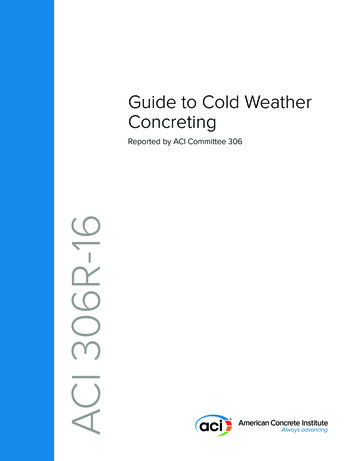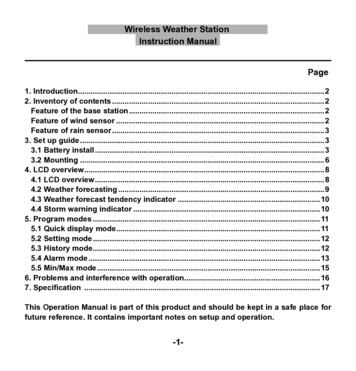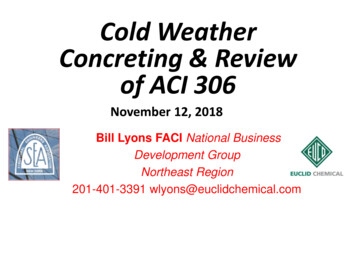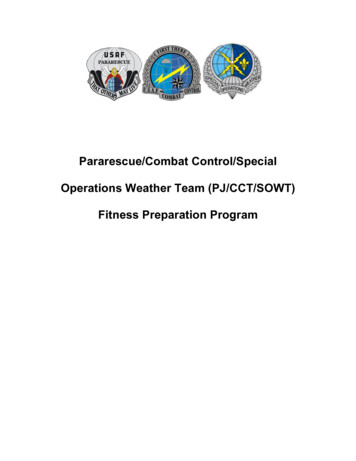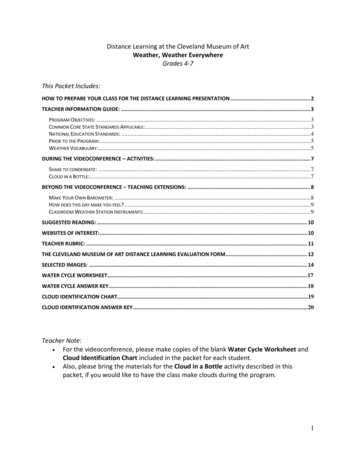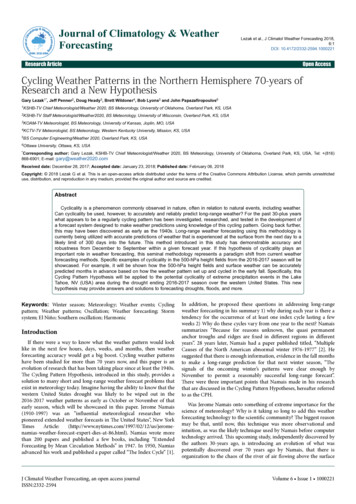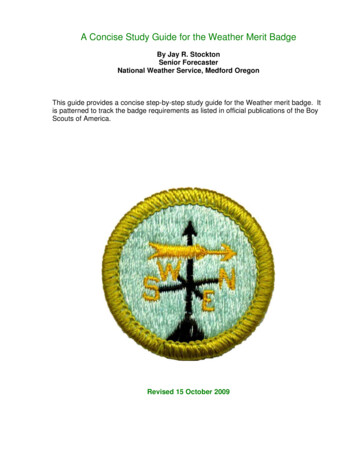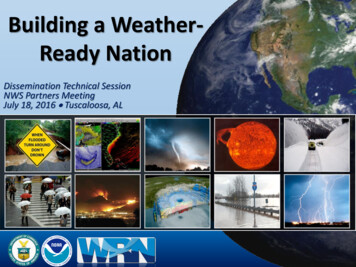
Transcription
Building a WeatherReady NationDissemination Technical SessionNWS Partners MeetingJuly 18, 2016 Tuscaloosa, AL
Table of Contents Integrated Dissemination Program (IDP) NWS Telecommunication Gateway (NWSTG) ReArchitecture Family of Services (FOS) Update Common Alert Protocol (CAP) Update MRMS and MADIS Upcoming Releases IDP Web/GIS Dissemination Services Open Data Initiative2
Integrated DisseminationProgram (IDP)3
Integrated Dissemination Program (IDP)The Importance of NWS DisseminationIntegrated DisseminationProgram (IDP) transformingNOAA’s enterprisedissemination servicesincluding NWS’ disseminationinfrastructure to provide timelyand reliable dissemination ofweather, water, and climatedata, forecasts and warningssupporting NWS’ mission toprotect life and property andenhance the national economy4
Integrated Dissemination Program (IDP)Office of Dissemination Benefits and ScopeOffice of Dissemination: Thrust Areas Service 1: Dissemination IT Infrastructure & Virtualized Application Services Service 2: Terrestrial and Satellite Networking Services Service 3: Weather Information Distribution Services5
Integrated Dissemination Program (IDP)OneNWS Network Long-Term Sustainable Solution100% DisseminationBackup with College Park andBoulder Physical Plant fit-up & ITEquip Install for IDPInfrastructure in Boulder NOMADS and FTPPRD backupin Boulder 100% backup at College Parkand Boulder: Sept 2016 – MADIS, MAG,MRMS, Radar Level 3, TGFTP,www.weather.gov Dec 2016 – NWSTG FunctionsRe-architected & NWSTGSilver Spring and FairmontretiredFunctionality already in place atIDP College Park(as of July 2016) NOMADS FTPPRD NWSTG Switch TGFTP* MADIS* MRMS* MAG* GMDSS Weather.gov nowCOAST IRIS/iNWS NWS GIS Services NOS Chart Tile Radar Level 2*Boulder Testing in ProgressThe future OneNWS Network will consolidate all operational networks (OPSnet, Regional, etc.)as single managed network under NCEP Central Operations (NCO).6
NWS TelecommunicationGateway (NWSTG) ReArchitecture7
NWSTG and the Transition to IDP NWS Telecommunications Gateway (NWSTG) The Legacy NWSTG is systems located at Silver Spring, MD and Fairmont, WV The design and IT complexity of the applications on the legacy NWSTG becameunsustainable IDP is addressing the weaknesses of the legacy NWSTG system IDP NWSTG Re-architecture Project The objective of the NWSTG Re-architecture project is the migration of theLegacy NWSTG functions (Silver Spring, MD and Fairmont, WV) to the IDPoperational infrastructure (College Park, MD and Boulder, CO) Goal is to provide scalable, robust, secure and commonly shared dissemination ITinfrastructure and distribution services to help protect life and property8
NWSTG Transition Approach to IDPStatus: July 2016Legacy NWSTGSystem7/31/2016:complete removalof all IT equipmentStep 1Silver SpringFairmont RADAR 3* FTP Push Socket FTP Mail HF-FAX WNG SNOTEL FTP incoming*IDP SystemEDISHCE*HCLNIDSGISCHADSFOSCollege Park TGFTPBMTNLETSGMDSSRADAR 2Weather.govCore Switch FTPSTGGATESFTPFNMOCSPOTRADAR 3*HCE*FTP Incoming*BoulderStep 1: Transition NWSTG Silver Spring, MD, softwareapplications to IDP College Park, MD Step 2TGFTP*Step 2: Enable NWSTG software application to run atIDP College Park, MD, or IDP Boulder, CO, providing100% backup capabilities by end of December 2016Step 3: Retire NWSTG Silver Spring, MD*Testing inprogress9
Family of Services(FOS)10
Family of Services (FOS) UpdateIDP and FOS Data ServicesNWS DisseminationIDPFOS100% BackupYes (FY17Q1)NoSingle Points of FailureNoYesMeets security statutes& PolicyYesNo - Violates FISMA,OMB 08-05 (TIC), andNOAA / NWS directivesNetwork capacity atInternet boundary20Gbps (scalable to100Gbps)1GbpsTypical messagethroughput per FTPsession for FOS18 Mbps –250 Mbps6 Mbps –45 Mbps (HIGHestimate based oncircuit size)Uptime availability99.0% (withoutbackup capability)99.9%Available Data (TB)Legacy FOSConnection - 20 TBIDP Environment - 500 TBLegacy FOS Connection - 20 TBIDP Environment 500 TBTypical Message Throughput per FTP Session300Bandwidth (Mbps)250Data and services on IDP include:200IDP Environment150250Legacy FOS Connection1005018645 All resolutions for GFS including 0.25 degreeHRRR, GEFS, SREF etc.MADISMRMSwww.weather.govGISNOMADS for customized gridded model productsPlus all NWSTG/FOS applications (RADAR Level 3 - July 2016)0LowHigh11
Family of Services (FOS) UpdateIDP System Design Approach IDP Dissemination Private Clouds enables resilient, scalable andsecure enterprise dissemination services Designed with internal redundancy Blade and enclosure redundancy with highly available network attached storage Diverse network paths with carrier grade network cores Uses virtualized technology to improve resource utilization Virtual machines highly availability and scalability Services are decoupled to improve robustness Ingest, Processing, and Database Services Web Services (HTTP) and Dissemination Services (FTP, LDM, etc) 100% Backup capability Provide geographically diverse backup capability for all applications and services inCollege Park and Boulder By December 2016, operational applications on IDP will have 100% backup capability12
Family of Services (FOS) UpdateFY15 / FY16 TimelineTRANSITION TIMELINEJan 2015Aug 2015Jan 2016Feb 2016Mar 2016Apr – Jun 2016AMS PartnersBriefingIDP Overview alongwith plans totransition away fromdirect connectionNWS formalrequest forcomments on thealteration ofthe FOS programthrough Oct 2015AMS PartnersBriefingStatus report on IDPand reiteratedtransition plansfrom directconnection2/12/2016:Face to facemeeting betweenNWS Leadershipand FOS PartnersMonthly TechnicalInterchangeMeetings begin insupport transitionfrom TGDATA andRADAR Level 3FOS testing ofTGDATA andconfirmation of IDPaccess for RADARLevel 3 dataTRANSITION TIMELINEJul 2016Aug 2016Sep 2016Start of 30-day test ofRADAR Level 3 datafrom IDP College ParkContinue RADAR Level3 testing &TGFTP and RADAR Level3 on IDP Boulder Failover testing between IDP College Parkand Boulder for TGFTP and RADAR Level 3 100% backup capability Turn off dedicated path between FOSpartners and OPSnet on Sep 30, 201613
Family of Services (FOS) UpdateTransitioned TGDATA to IDP TGFTPAs part of the continuing NWS Telecommunications Gateway (NWSTG) application transition to IDP,NCEP transitioned the public anonymous ftp services from the legacy systems in Silver Spring, MD tothe IDP environment in College Park, MD.This ftp server also fulfills international commitments for data distribution and, most importantly, themigrated application provides backup service capabilities for the first time.All data on TGDATA (NWSTG FOS Server name) transitioned to TGFTP on IDPTGFTP Capabilities Access to a variety of weatherproducts including climatedata, forecasts, observations,watches and warnings 100% backup capability (bySeptember 2016) Public accessTGFTP is available at: ftp://tgftp.nws.noaa.gov/14
Family of Services (FOS) UpdateRADAR Level 3 on IDPRadar Level 3 Migration Status 30-day test began on June 29, 2016 Customers currently evaluating the data Feedback to date: Products are being received quicker on theIDP (13 seconds) than through FOSmethod (18 seconds) RADAR Level 3 operational on IDP Aug 9, 2016 Radar Level 3 will be available on IDP Bouldersystem by September Failover testing between College Park andBoulder will occur in SeptemberThe latest Radar Level III data is available at: r/http://radar3pub.ncep.noaa.gov/15
Family of Services (FOS) UpdateIDP Overall Management Approach Single, accountable organization (NCO) managing themonitoring and performance of a technically robust system Defined, repeatable 7/24 operational support includingimproved monitoring and problem resolution processes Improved reliability using mature configuration management,security patching and applications onboarding processes16
Family of Services (FOS) UpdateIDP Continuous Monitoring ProceduresWhat metrics do we monitor? Uptime – 99% today / 99.9% with full backup capabilityDownload speed – application dependentBig BrotherWebsite Load time – application dependentNetwork – use Scrutinizer monitoring tool for inbound / outbound trafficData Ingest - monitor data counts17
Family of Services (FOS) UpdateIDP Weekly Monitoring ProceduresWhat metrics do we monitor? I/O Bandwidth – monitor at the system levelCPU Utilization – monitor at the system and application levelLatencies – application and services basedWeekly averaged load time at locations across the U.S.Weekly averaged download time at locations across the U.S.Big BrotherCollege Park - IOPSNCEP Central Operations defines theoretical maximums and procurement pointsfor all critical resources and review them on a weekly basis18
Family of Services (FOS) UpdateIDP Escalation ProceduresReporting / Escalation Procedures are unchanged301-713-0902 / TOC.nwstg@noaa.gov or SDM@noaa.govBen Kyger, NCO Director,Ben.Kyger@noaa.gov 24x7 Tier I coverage ranging from 6 – 12 team members on shift at anyone time for operational monitoring of critical NWS systems,applications, and data If multiple calls are received at the same time calls are automaticallytransferred to another staffed desk Once an issue is reported, a ticket is opened immediately for trackingpurposes and Tier II staff is contacted within minutes based onStandard Operating Procedures19
Common Alert Protocol(CAP)20
Common Alerting Protocol (CAP)UpdateBackground CAP allows emergency messages to be simultaneously disseminated over a widevariety of existing and emerging public alerting systems In addition to the basic CAP standard, a supplemental Integrated Alert andWarning System (IPAWS) Profile technical specification was developed to ensurecompatibility with existing warning systems used in the United States FEMA has formally adopted CAP v1.2 and the IPAWS Profile to implement IPAWS Systems that use CAP: Emergency Alert System (EAS) Participants include radio, TV, cable, broadcast, satellite, and wireline providers Participants were required to upgrade their equipment to be able to receive CAP alerts underFCC rules Wireless Emergency Alerts (WEAs) Transmitted to the IPAWS-Open Platform for Emergency Networks (OPEN) in CAP format In the Spring 2016, NWS Senior Management was made aware of software bugscontained in CAP v1.221
Common Alerting Protocol (CAP)UpdatePhase 1 – Post-Processed CAPThis “post-processed” method is a stop gap approach for support of theFEMA/IPAWS Wireless Emergency Alerts channel, a permanent CAP originationcapability will be implemented in AWIPS Hazards Services Phase 1 – addressing the bugs includes: WMO Products and headlines are not parsed correctly and/ordata is missing in output resulting in over warning for some Flash Floods CAP message does not properly display precautionary/preparedness informationthat is listed in the WMO message resulting in incorrectly placed product content Alerts are not distributed or are inadequately distributed for some watch, warning,advisories that have multi-line VTEC codes The CAP messages do not contain all the WMO-formatted parameter elements resulting innot being able to always reproduce headlines and other data currently in the WMO productsfrom CAP v1.2Corrections for these known data/message defects will be implemented by FY17 Q2.22
Common Alerting Protocol (CAP)UpdatePhase 2 – Hazards Services Generated CAPHazard Services Produce Hydrologic related hazards using a new framework that replaces the capabilities that reside within AWIPS WarnGen , GHG,and RiverPro applications Implement new capabilities to generate hazards more effectively / efficientlyBenefits/Highlights: Streamlines the hydro warning process within the forecast office Enables modern communications protocol (e.g., CAP, XML, etc.),and future capabilities (e.g., Probabilistic Hazards, Hazardsimplification) Reduces the cost of O&M for the watch, warning and advisoryapplicationsHazard Services Tentative Schedule Framework and Hydrologic Products deployment in 2019 Remaining Products between 2019 and 2020Potential Transition to Hazard Services CAPmessages Hydrologic products in 2019 Remaining watches and warnings in 2020 Decommissioning of the “post processing” method in 202123
UpcomingMRMS & MADIS Releases24
MRMS Upcoming Releaseson IDPMRMS v11.0.0 (FY16 Q4)The MRMS system was developed to produce severe weather and precipitation productsfor improved decision-making capability for severe weather forecasts and warnings,hydrology, aviation, and numerical weather prediction.Additions and updates for v11.0.0include: infrastructure efficiencies lightning product enhancements improved gauge data ingest and qualitycontrol RIDGE2 support MDL’s AutoNowCasterv11.5.0 (FY17Q2) and v12.0.0 (FY17Q4)are planned for next year.Partners can request a subscription service to MRMS,via LDM, at any time.Have a question or need help getting started?Send an email to ncep.list.idp support@noaa.gov with thesubject line ”MRMS LDM request".25
MADIS Upcoming Releaseson IDPMADIS v2.1.5 (FY17 Q1) – Full Clarus functionalityMADIS is a meteorological observational database and data delivery system that providesobservations that cover the globe.Updates in v2.1.5 include: Clarus is a research and development initiative todemonstrate and evaluate the value of “Anytime,Anywhere Road Weather Information” provided byboth public agencies and the private weatherenterprise to transportation users and operators.Partners can request a subscriptionservice to MADIS, via LDM, at any time.Have a question or need help getting started?Send an email to madis-support@noaa.govwith the subject line "Clarus transition". Federal Highway Administration (FHWA),NWS, and the Office of Oceanic andAtmospheric Research (OAR) agreed thatMADIS should become the operational homefor Clarus. Version 2.1.5 also includes HADS and SNOTELprocessing migrated from the NWSTelecommunications Gateway system.26
IDP Web/GISDissemination Services27
Available IDP Dissemination ServicesIDP Web and Geospatial Services (GIS) Standup and Maintain an Enterprise GIS Infrastructure–Leveraging web services and GIS to disseminate NOAA and NWS critical data toforecasters, NOAA users, Federal partners (Federal Aviation Administration (FAA)and Federal Emergency Management Agency (FEMA)), International communityand public– Implementing net-centric weather information dissemination capability to fulfillNWS’ role for the Next Generation Air Traffic System (NextGen)– Onboarding current GIS capabilities onto operational dissemination infrastructure– Establishing common format framework foroperating GIS data sets Establishing consistent metadata and aconsolidated catalog for discovery and accessof NOAA and NWS geospatial content28
Available IDP Dissemination ServicesIDP GIS – nowcoast.noaa.gov Provides users with situational awareness/coastal intelligence of the recent past,present, & future environmental conditions for the United States Integrates near-real-time data, analyses, warnings, forecasts, and model guidance fromNOS, NWS, NESDIS, and other federal agencies Provides these data & information via REST map services & OGC compliant WMSWeb Map ServicesnowCOAST Map ViewerFifth Third Bank Map ViewerU.S. DHS COP Viewer29
Available IDP Dissemination ServicesIDP GIS – Climate Hazardsidpgis.ncep.noaa.govProvides the ability to gather the information you need and add thedata to your own map.30
Available IDP Dissemination ServicesIDP GIS – Climate Related31
Open Data Activities32
Open Data InitiativeKey Takeaways Survey was released in June 2014 to obtain feedback on: additional weather prediction model output needs the required format of the data, and how long to make the data available for evaluation purposes NWS received 7 responses to the survey A consistent message was received for NWS to providehigher resolution model data both temporally and spatiallyin GRIB2 or netCDF format for all models A total of 18 specific requests were received33
Open Data InitiativeCompleted Responses to Requests as lated Satellite output from the GFSFTPPRD, NOAAPORTRequest assimilation of automated commercialaircraft reports in GFS, NAM, SREFData assimilated in modelsAccess to post-processed model grids producedby NCEP Centers – such as OPC, NHC, SPCNDFD grids are publicly st of Center-specific m complete.xlsAccess to model catalog on NCEP producedmodel dataAvailable at: http://www.nco.ncep.noaa.gov/pmb/products/Evaluate model output from one month to twoyears prior to implementation Access to the “Extreme Weather Index” toolscurrently in experimental modeThe NCEP process for model evaluations includes a 30-daycustomer evaluationNCO will review options for access during modeldevelopmentAvailable at: http://ssd.wrh.noaa.gov/satable/An operational implementation date has not been determined34
Open Data InitiativeCompleted Responses to Requests as ide consistent temporal resolution for GFSafter F192Extend consistency to 3 hourly from F000 to F240, 12-hrly F240to F384. Completed 1/14/2015Dissemination methods: FTPPRD, NOMADS, NOAAPORT, MAGAdd BUFR sounding data for The NetherlandSchiphol Airport and the Japan Narita AirportCompleted 1/14/2015Dissemination method: FTPPRDRemove GEFS delay in products between F192and F204Completed Q1FY160.50o resolution output for entire modelSpatial resolution consistency will reduce delayDissemination methods: FTPRPD, NOMADS, NOAAPORT, MAGIncrease GEFS spatial resolutionHourly output from the GFS through 8 days 5daysCompleted Q3FY16FTPPRD, NOMADSMAG in August 2016Customer would like separate meeting withNCO to discuss data sampling and formatsComplete Continually meet with customers throughout theyear at various conferences and partner meetingsAccess to GFS in its native resolutionNCEP Central Operations provided a test dataset of the GFSmaster grib files on 5/4/2016. Link to data com/gfs/35
Open Data InitiativeLong Term Action or On Hold as of 7/18/2016RequestResponseIssue with RequestSimulated Radar data from the GFSNo Plans to include in FY17Issue is due to the sophistication of themicrophysics schemeProvide earlier availability times for GFSand GEFSTimes of the model output arebased on data input cutofftimesAccess to commercial airline dataassimilated into modelsThe ACARS data is restrictedTerms of the contract with the dataprovider prohibit redistribution of thisdataAccess to ATCF model guidance for theglobal forecast basinsAtlantic, East Pacific, andCentral Pacific ATCF guidanceavailable via NHCftp://ftp.nhc.noaa.gov/atcfJTWC, part of the U.S. Navy, does notpublicly make the guidance available forthe Western North Pacific, NorthernIndian, and Southern Hemisphere.Provide ability to customize data requestsunder a unique login to prevent outsideparties knowing which customer accessescertain data typesNWS must ensure equalaccess to data for allcustomers.36
THANK YOU!37
IDP Continuous Monitoring Procedures 17 Big Brother What metrics do we monitor? Uptime – 99% today / 99.9% with full backup capability Download speed – application dependent Website Load time – application dependent Network – use Scrutinizer monitoring tool for inbound / outbound traffic
